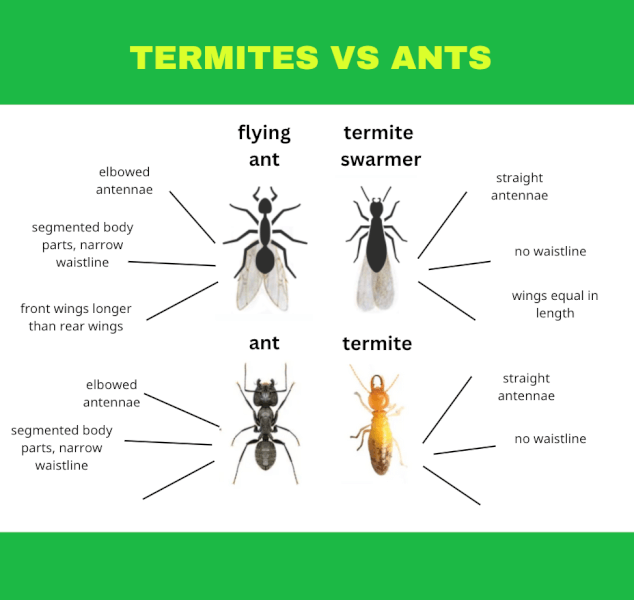Termites vs. Ants: Expert Tips on Recognizing and Dealing with Infestations
We’re coming up on termite swarmer season in the Kansas City area, and one of the inquiries we receive most often around this time of year is regarding the difference between flying ants and termite swarmers.
Swarms are provoked by heavy rainfall and warm, humid temperatures, so most species of subterranean termites swarm during the spring and summer months, typically on a warm day with calm winds after rain. Swarms occur when established termite colonies produce winged male and female termites in order to reproduce.
According to PCT Magazine, since numerous species of termites and ants swarm at the same time of year and they somewhat resemble each other, they can easily be confused for each other.
TERMITES VS. Flying ANTS: PHYSIOLOGY
Despite sharing a common taste in their diets, ants and termites are fundamentally different insects. As such their physical makeup sets them apart from one another. First, termites have a two-section body shape, consisting of a head and thorax.
Their general shape flows from one section to the next with little deviation. Flying ants instead have a three-section structure to their body. Along with a head and thorax, ants have an abdomen section, showing two clear indentations from the other sections.
Both insects may also have wings, these are reproductive swarmers that emerge from existing nests to go find a suitable location for a new nest. Termite swarmer wings are typically longer than carpenter ants’ but without comparing the two it can be difficult to make that determination.
How to Tell The Difference Between The Bodies of Termites and Ants?

TERMITES VS Flying ANTS: BEHAVIOR
There is one critical difference to understand between termites and carpenter ants. While both have the same target in your home, they have different goals. Termites eat wood. In fact, they can eat through most solid materials like stone and concrete to get to wood deposits that they consume to nurture their hive.
Carpenter ants (a type of flying ant) do not eat wood. Instead, just as their name suggests, they choose to make their nests in wood deposits the same way other ants construct galleries in soil.
The result of this difference is in the pace and manner that the infestation takes place. Termites are renowned for their voracious appetites, They will quickly eat through deposits, constructing protective tunnels to shield them from any exteriors, and leaving behind droppings.
Carpenter ants will instead methodically work through the wood in your home, constructing their tunnels and galleries. Then they will likely venture into your home in search of food the same way other ants do.
TERMITES VS Carpenter ANTS: IMPACT
One thing that termites and flying ants have in common is they both can cause structural damage, although there is a pretty significant difference in the level of destruction.
Termite Damage – A Serious Threat
Termites are notorious for their destructive effects on structures, especially those made of wood. They consume cellulose, which is found in wood, wallpaper, flooring, and other building materials, potentially leading to significant structural damage.
Termite damage can be extensive and is often hidden until it becomes severe. They can silently eat away at the internal structure of your home, causing serious damage that can be very costly to repair. They are considered one of the most destructive insects.
Did you know that termites cost Americans more than $5 billion in damage each year? Homeowners must legally inform buyers of a termite infestation, as these pests could compromise the structural integrity and appraisal value of the home. It is estimated that termite damage could decrease a home’s value by up to 20%, making them a true PEST.
Carpenter Ant Damage – Annoying but Manageable
As mentioned above, flying ants, or carpenter ants when referring to those that impact wood, do not eat wood but excavate it to create nests. This can weaken the wood, but usually does not affect structural integrity as severely as termite damage. The damage from carpenter ants is done over longer expanses of time and their swarms are usually a lot easier to spot.
While flying ants can be a nuisance and may lead to some repair costs, the economic impact is significantly less compared to termites.
Looking For A Termite Inspection In Kansas City?
If you’re still unsure whether you’re facing a termite or flying ant issue, don’t take any chances. At Gunter Pest, we understand the urgency and potential costs of pest infestations. That’s why we offer comprehensive termite inspections for just $65—a small price to pay compared to the $3,000 to $50,000 in damage that termites can cause to your property.
Protect your home and your investment by letting our experts provide you with peace of mind. Kansas City homeowners, reach out to us today and ensure your home is safe and sound.
Call or email our local team in Waldo at any time:
Be Sure To Check Out Our Services:
Termites — Commercial Pest Control — Residential Pest Control — Bed Bugs








